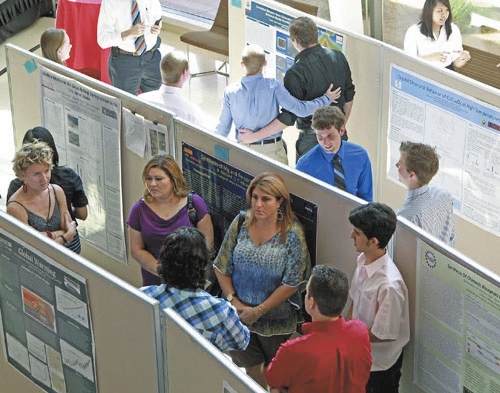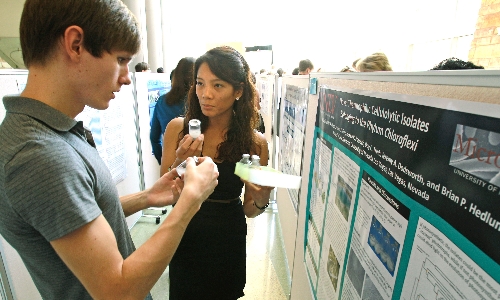UNLV attracts students for summer science research projects
While studying microbes and sludge in a Chinese village over the summer, Joseph Peacock was awakened one morning by the squeal of a pig being slaughtered.
That is part of being a scientist.
So is realizing that the hotel you are staying in is using the very same water from the hot springs where you study the sludge and the microbes, single-cell organisms that include bacteria. But he wasn't complaining. That's just the way it is doing fieldwork.
"It was very livable," Peacock said.
He and his colleagues were all over China this summer, from near the southern border with Myanmar to a national park to a conference in Beijing.
Peacock, 33, is a senior studying microbiology at UNLV. He is one of the lucky few dozen undergraduates who got to spend this summer working on research projects here and around the world.
Being able to participate in research as an undergraduate is a huge opportunity, Peacock said.
He and his team were among several teams studying hot springs. The teams worked under UNLV professor Brian Hedlund, a leading researcher in the field.
In this case, they were looking to see whether they could find similar patterns among the microbes and chemicals in different hot springs around the world.
This could be important. Who knows what's in there? Could be a new source of energy. Could be new drugs. Could be anything, really. Few people have looked before. If they find something cool, maybe they can figure out how to mass produce it.
Peacock and about 50 other students presented their projects at the university this week.
It was all part of the Undergraduate Research Opportunities Program and the Research Experience for Undergraduates Program. UNLV is one of many universities that participate in these. About half of the 50 students involved at UNLV are actually students from other universities who came to Las Vegas for the summer research, often drawn by the status of a particular professor.
The programs are funded through federal research grants from the National Science Foundation, the National Institutes of Health, and the National Aeronautics and Space Administration, among others.
Most of the research projects presented were extremely complicated but one day could lead to important discoveries that will matter to real people.
Like this one: "Inactivation of spoOA gene increases stationary phase mutagenesis in bacillus subtilis."
Gibberish, right?
Not to Denisse Reyes.
She is 22, a senior at California State University, San Marcos. She had been planning to go to pharmacy school, but her participation in the research project this summer has her thinking now that she wants to be a scientist.
That's because what she and her team did was kind of amazing.
They got this bacteria and removed a gene from it. It turned out that this caused the bacteria to mutate a whole lot more than it normally did.
This is important knowledge that they discovered.
Bacteria mutate all the time. The ones that make people sick sometimes mutate into even scarier bacteria. Sometimes they mutate into bacteria that can resist antibiotics. That means that doctors can have a much harder time curing the diseases the bacteria cause.
Reyes and her team's research isn't going to cure cancer just yet, but it is a tiny step toward figuring out how to stop people from getting sicker.
Tim Porter, dean of the College of Sciences, said most scientific discoveries are actually small steps in the vast accumulation of knowledge. Occasionally, someone makes a massive discovery, but that's the exception.
This program, the opportunity for undergraduates to participate in those very scientific discoveries, is important, Porter said.
"They learn to research," he said. "What it really means to go into a lab and do real science."
He said the process typically works like this for the undergrads: A professor who is usually already working under a science grant applies specifically for an undergraduate summer research grant.
Research grants usually run for three years and provide a set amount of money. The professor then uses that money to buy equipment, fund travel and pay a small stipend to the students who make the cut.
And voila. You've got 22-year-old scientists working in university laboratories beside graduate students and professors.
The program is not funded by one giant grant but rather many small grants that vary in size.
Regardless, like regular scientists, the undergraduate researchers usually make small discoveries that add to the overall knowledge pool. Maybe those little discoveries add up, and maybe someday we all benefit, whether we know where it all came from or not.
Porter said only the top students participate, after a rigorous application process.
"These are going to be the minds, the scientists, the engineers, who enable you and me to live to 100 years old. Who find a cure for cancer or design an automobile that gets 80 miles per gallon or find life on another planet," he said.
"Who knows?"
Contact reporter Richard Lake at rlake@reviewjournal.com or 702-383-0307.


















